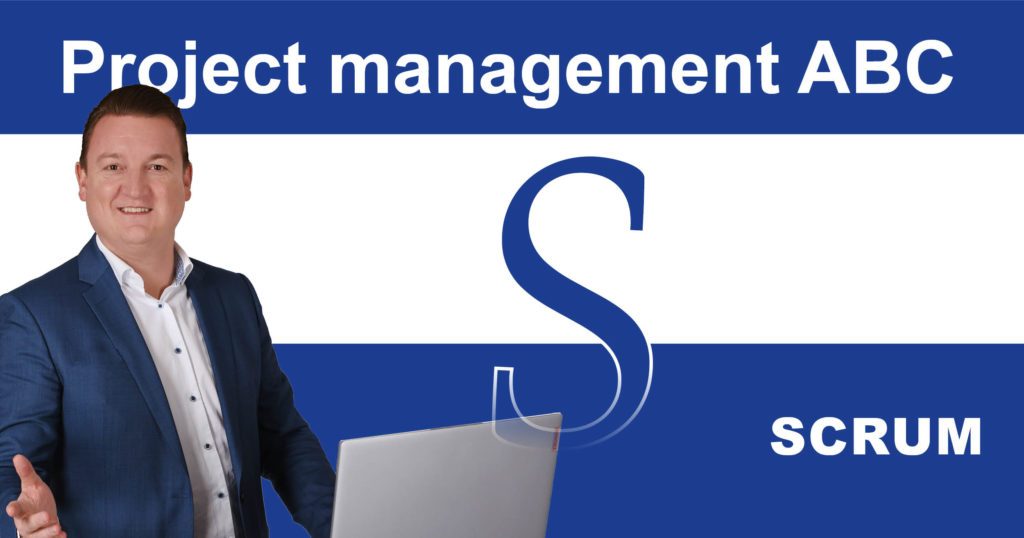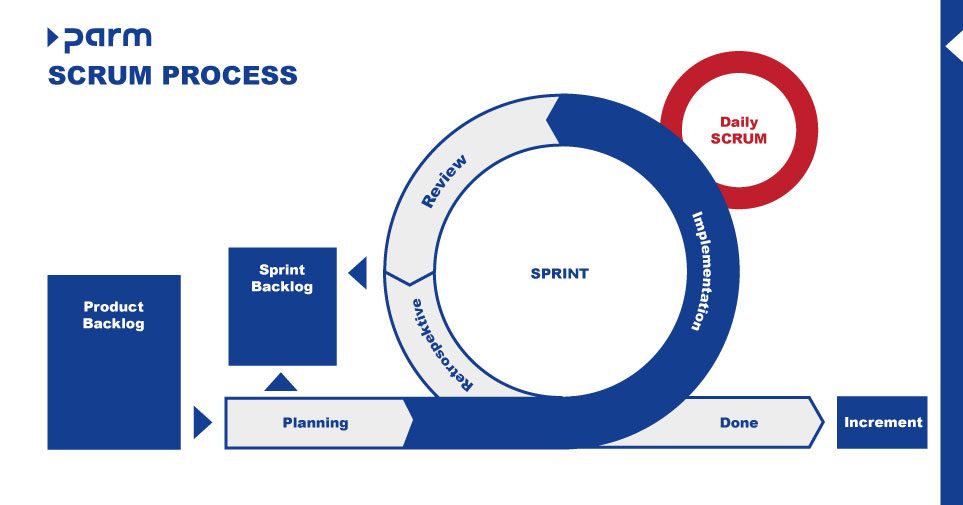Project management ABC: S for Scrum
Efficient teamwork with SCRUM: principles, roles and ceremonies

Flexibility and efficiency are often crucial to the success of a project. This is where SCRUM comes into play, an agile framework that was originally developed for software development but is now used in many industries. SCRUM helps teams to divide complex projects into manageable, incremental steps to achieve results faster and more effectively.
What is SCRUM?
SCRUM is an agile framework that supports teams in developing and delivering complex projects in small, manageable steps. It is based on iterative and incremental processes that enable continuous improvement and adaptation. SCRUM is mainly used in software development but has also gained importance in other areas.
SCRUM was developed in the early 1990s by Jeff Sutherland and Ken Schwaber. Both were looking for a flexible and effective approach to overcoming the challenges of software development. They aimed to create a framework that would help teams respond faster and better to changing requirements and complex projects.
The term “SCRUM” itself comes from rugby and refers to a formation in which the team works closely together to advance the ball. This metaphor illustrates the collaborative and iterative approach of SCRUM, in which the entire team works together to complete a project.
The three pillars of SCRUM
SCRUM is based on the idea of carrying out a project in recurring iterations (sprints) instead of planning in advance. In each iteration, knowledge is gained that is used in the next cycle. Three pillars therefore form the basis of SCRUM:
- Transparency: all aspects of the process must be visible and understandable to all participants. Transparent processes and goals promote trust and cooperation within the team.
- Inspection: Regular reviews of work and progress are crucial to identifying and solve problems at an early stage. SCRUM ceremonies such as Daily SCRUM and Sprint Review provide suitable opportunities for this.
- Adaptation: Based on the results of the inspection, the team continuously adapts its way of working. This enables a rapid response to changes and new findings.
The roles in the SCRUM team
In SCRUM, there are three main roles, each with specific tasks and responsibilities: the SCRUM Master, the Product Owner, and the Development Team. These roles are clearly defined to ensure that all aspects of the project are managed and implemented effectively.
1. SCRUM Master
The SCRUM Master is responsible for ensuring that the process is adhered to. He functions as a process coach, mentor, and moderator. As a servant-leader, he serves the team by removing obstacles. He also promotes continuous improvement, leads the SCRUM ceremonies, and trains the team members in the principles of SCRUM. They cannot exercise any substantive control over the project team and do not give instructions, but only ensure that the team can work productively and that they are protected from external influences so that a productive workflow can be maintained.
2. Product Owner
The product owner is responsible for the project content and is the central point of contact for all matters relating to product development. They are therefore responsible for requirements management by defining and prioritizing the product requirements in the product backlog. The product owner also acts as a link between the development team and the stakeholders. In this way, they ensure that the product meets customer expectations and needs. The product owner develops and communicates the product vision, ensuring the team works toward long-term goals. They also make decisions about the scope and priority of tasks for each sprint.
3. Developer
The development team is responsible for implementing the project content. Such a team should be multidisciplinary (cross-functional). This means that it should consist of specialists with different skills who work together to implement the tasks. The team therefore usually consists of three to nine members, so that it is small enough to reduce communication costs and at the same time large enough to cover all the necessary qualifications. This is important because the development team organizes itself and decides independently how best to complete the work at hand. This team delivers a finished, potentially deliverable product increment at the end of each sprint. In addition, the team regularly reflects on its own work processes and results to continuously optimize them.
Collaboration between the roles is crucial to the success of a SCRUM team. The SCRUM Master ensures that the processes run smoothly, the Product Owner defines clear goals and priorities, and the development team implements them efficiently. Through regular communication and collaboration, they ensure that the product is continuously improved and adapted to the customer’s needs.
Artifacts in SCRUM
In SCRUM, three central artifacts support the development process and keep everyone informed about the current status and progress: the product backlog, the sprint backlog, and the increment.
1. Product Backlog
The product backlog is an ordered list of requirements and tasks that are necessary for the development of the product. It includes all functions, improvements, and bug fixes that are to be made to the product. In contrast to a requirements catalog in classic project management, the product backlog is dynamic, i.e. new requirements are continuously added and existing ones can be changed or removed. The entries are prioritized according to their importance based on the business value and the requirements of the stakeholders. The top entries with a high priority are usually clearly described in detail, as they are to be implemented shortly, while entries further down the list are only specified over time.
2. Sprint Backlog
The sprint backlog is a list of tasks that the development team wants to implement during a sprint. It is created at the start of each sprint in the sprint planning meeting and is based on the highest priority entries in the product backlog. The sprint backlog therefore only contains the tasks that the team wants to implement in the current sprint to achieve the sprint goal. It is supplemented by a plan of how the tasks are to be implemented, for which they are broken down into subtasks. It can be adapted and updated during the sprint if necessary to ensure that the sprint goal is achieved.
3. Increment
An increment is the result of the work of all tasks completed during a sprint plus the increments of the previous sprints. It thus represents a further step towards the final product and shows that the product becomes more valuable and more comprehensive with each sprint. Regardless of whether an increment is used productively, later on, it must be functional and potentially deliverable. At the end of each sprint, the increment is presented and reviewed in the sprint review to ensure that it meets the requirements and provides valuable input for further development.
The artifacts in SCRUM are closely interlinked and together play a decisive role in the success of the project. The product backlog provides the basis for the work in the sprint backlog, and the implementation of this work leads to a new increment. This structure enables iterative and incremental development, which promotes flexibility and continuous improvement.
Events in the SCRUM framework
In contrast to traditional project management, agile project management does not have predefined phases, but rather cyclical iterations. In SCRUM, these iterations are called sprints and form the core of all SCRUM projects. Each project consists of several sprints, which should be a maximum of one month long and in which a defined goal is to be achieved. The Sprint Planning, Daily SCRUM, Sprint Review, and Sprint Retrospective events take place in each sprint. There is also the Refinement (Backlog Refinement) meeting. These meetings, also known as ceremonies, serve to ensure that the team works together effectively, that progress is regularly reviewed, and that the work and the product are continuously improved.

1. Sprint Planning
Sprint planning is used to plan the work for the next sprint. This is where the team determines which tasks from the product backlog are to be worked on in the next sprint. The duration is a maximum of 8 hours for a 4-week sprint, whereby the duration should be correspondingly shorter for shorter sprints. In this meeting, the goals for the next sprint are set by the product owner presenting the highest priorities from the backlog and explaining the goals for the sprint based on these. The team then discusses and selects the backlog items that can be implemented in the sprint. It then draws up a detailed plan of how these items can be converted into working increments.
2. Daily SCRUM
The Daily SCRUM is a short daily meeting to review progress and update the plan for the next 24 hours. The meeting is often referred to as the Daily Standup, as it is usually held standing up and should only last a maximum of 15 minutes. In practice, three questions have become established that should be answered by each team member in the meeting:
- What have I done since the last Daily SCRUM?
- What will I do before the next Daily SCRUM?
- What obstacles are in my way?
3. Sprint Review
At the end of each sprint, a sprint review is carried out in which the increment is presented and the team receives feedback from the stakeholders. The product backlog is then adjusted based on the findings of the sprint, the feedback received, and possible changes to the market. This meeting should last a maximum of 4 hours for a 4-week sprint and is a very important event because it involves direct communication between the developers and the stakeholders.
4. Sprint Retrospective
In line with the principle of reviewing and adapting, the team reflects on the past sprint in the sprint retrospective and identifies opportunities for improvement for future sprints. In the meeting, which lasts a maximum of 3 hours, the positive aspects of the past sprint (What went well?) and the challenges and problems (What didn’t go well?) are analyzed. Based on this, action plans are developed for improvements to working methods, collaboration and processes.
5. Backlog Refinement (also Backlog Grooming)
The only SCRUM meeting that does not follow a defined structure is the backlog refinement meeting. It is used to update the product backlog and ensure that the entries are well understood and prioritized. The existing entries are reviewed and updated. Higher prioritized items are described in more detail to make them ready for future sprints and the effort for the new or updated items is estimated.
Conclusion
SCRUM offers a proven methodology for managing complex projects by enabling teams to work more efficiently and flexibly. Through the clear structure of roles, artifacts, and ceremonies, SCRUM promotes a transparent and collaborative way of working that is geared towards continuous improvement. This not only leads to higher productivity and greater satisfaction within the team but also to better and faster results for customers and stakeholders. Whether you are a newcomer or an experienced user, SCRUM offers valuable approaches and tools to successfully master the challenges of modern projects.
If you would like to experience the benefits of SCRUM in your project management, the myPARM project management software could be the ideal complement. With numerous functions to support agile SCRUM processes, myPARM is a user-friendly platform that helps your team to work together efficiently and effectively.
Learn more about the project and portfolio management software myPARM:
Would you like to get to know myPARM in a demo presentation? Then make an appointment with us right away!
